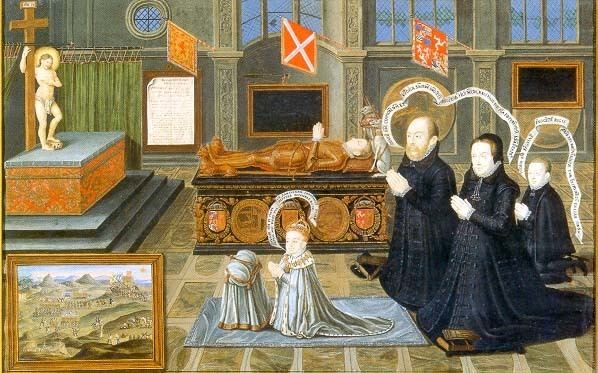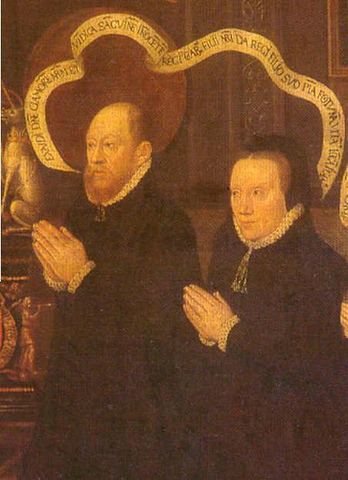Mother Elizabeth Stewart | Name Matthew Stewart 4th | |
 | ||
Born 21 September 1516Dumbarton Castle ( 1516-09-21 ) Spouse Margaret Douglas (m. 1544–1571) Parents John Stewart, 3rd Earl of Lennox Children Henry Stuart, Lord Darnley, Charles Stuart, 1st Earl of Lennox Similar People Margaret Douglas, Henry Stuart - Lord Darnley, Lady Arbella Stuart, Archibald Douglas - 6th Earl o, Margaret Tudor | ||
Matthew Stewart, 4th Earl of Lennox (21 September 1516 – 4 September 1571) was the fourth Earl of Lennox, and a leader of the Catholic nobility in Scotland. He was the son of John Stewart, 3rd Earl of Lennox. His grandson was James VI of Scotland.
Contents

Conflict with Regent Arran (1543–1547)
He spent most of his youth in exile in England, but returned to Scotland to assert his claims to the line of succession when James V died in 1542. At the time of the king's death in 1542, Lennox possessed a strong claim to the throne of Scotland should Mary, Queen of Scots, an infant, pass away childless. He was James V's second cousin once removed, being a great-grandson of Mary Stewart, Countess of Arran, James II's daughter, through her daughter, Elizabeth Hamilton. However, the Earl of Arran, James Hamilton, was descended from a son of the Countess of Arran, and thus held the stronger claim. As a result, Lennox was at best third in line of succession, and really behind Arran's sons. Arran was made Regent of Scotland. In 1543, Lennox's supporters challenged Arran's claim and legitimacy by suggesting that his father's divorce and second marriage were invalid.
Lennox arrived at Dumbarton Castle with two ships in March 1543. He came to Edinburgh, but refused to ratify Arran's position as second person and Regent. Arran was pushing towards alliance with England and made the Treaty of Greenwich on 1 July 1543, agreeing to a marriage between Mary, Queen of Scots, and Henry VIII's son Edward, Prince of Wales. Arran began to fortify Linlithgow Palace, where Mary was held with her mother Mary of Guise. Cardinal Beaton's and Lennox's supporters camped outside the palace but lacked artillery for an assault. Their representatives parleyed with Arran's men at Kirkliston, near Edinburgh, and a settlement was reached. Henceforth, Arran would rule with the advice of a council, and the infant queen would be moved to Stirling Castle. Lennox escorted Mary to Stirling on 26 July 1543.
Although Lennox had come to Scotland lured by the prospect of marriage to Mary of Guise, by September, Lennox had been offered the chance to marry Lady Margaret Douglas, daughter of Margaret Tudor and half-sister of the deceased James V. After Lennox seized French money and artillery sent to Mary of Guise, she even offered the hand of her daughter in marriage. When the Parliament of Scotland rejected the Greenwich treaty, Lennox then changed sides and supported Henry VIII of England's military efforts to secure a marriage between Queen Mary and his son and heir Edward, Prince of Wales, in the War of the Rough Wooing. After the defeat of his supporters at the Battle of Glasgow Muir, he fled once more to England.
When the English army approached Edinburgh before the Battle of Pinkie Cleugh, far to the west a diversionary invasion of 5000 men was led by Thomas Wharton and Lennox on 8 September 1547. They took Castlemilk and burnt Annan after a bitter struggle to capture its fortified church.
Marriage and later life
In 1544, he married Lady Margaret Douglas, who had a claim to the English throne. Their children were: Henry, born in 1545 at Temple Newsam, who eventually married Mary, Queen of Scots; and Charles, born in 1556 and died in 1576, who married Elizabeth Cavendish in 1574. Elizabeth was the daughter of Sir William Cavendish and Bess of Hardwick. Lennox's grandchildren were: by Henry, King James VI of Scotland and I of England, and by Charles, Lady Arbella Stuart.
In August 1548, he made four promises to Mary of Guise in order for her assent to her daughter's French marriage. These were: that he and his friends and retainers would preserve the Catholic faith in Scotland; they would guard the Auld Alliance; Guise would remain guardian of the Queen; and he would punish all who supported the king of England.
He returned to Scotland upon Elizabeth I of England's urging during the marriage negotiations of Mary, Queen of Scots, in 1564. He quickly took up his position as the most powerful lord in the Glasgow area and was instrumental in the marriage of his elder son, Lord Darnley, to Mary. Whether Elizabeth had intended this (in order to eliminate the threat of a continental marriage), as is sometimes conjectured, remains doubtful. Elizabeth reacted with disapproval and had Lennox's wife confined in the Tower of London. By August 1565, William Cecil had heard that Darnley's insolence had driven Lennox from the Scottish court.
After Darnley was murdered early in 1567, Lennox was the most ardent pursuant of justice against the lords who had conspired in the murder. He also became the main witness against Mary, though her involvement in the murder, thought to have been carried out by her later husband, Lord Bothwell, is controversial.
In 1570, Lennox became regent for his grandson, James VI, but the queen's party declared war against him. He was shot dead next year in a skirmish when the queen's party attacked Stirling. The raid on Stirling on 4 September 1571 was led by the Earl of Huntly, Claude Hamilton, and the lairds of Buccleuch and Ferniehurst. Early reports said he was killed by his own side. William Kirkcaldy of Grange said the shot was fired by the queen's party, and another account names David Bochinant as the assassin.
